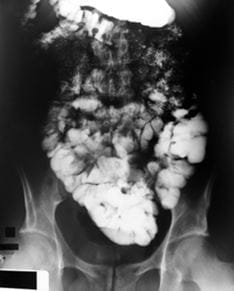Non-Invasive Imaging for Small Bowel Disorders
 Computed tomographic (CT) enterography is a diagnostic procedure that uses a CT scanner and contrast material to view the inside of the small intestine. CT enterography has become an important alternative to traditional fluoroscopy in the assessment of small bowel disorders such as Chron's disease, inflammatory bowel disease, celiac sprue and small bowel neoplasms.
Computed tomographic (CT) enterography is a diagnostic procedure that uses a CT scanner and contrast material to view the inside of the small intestine. CT enterography has become an important alternative to traditional fluoroscopy in the assessment of small bowel disorders such as Chron's disease, inflammatory bowel disease, celiac sprue and small bowel neoplasms.
Radiologists use CT enterography to:
- Identify and explore inflammation in the small intestine
- Look for tumors
- Find obstructions and/or abscesses in the bowel
- Identify a source of bleeding
CT enterography is a quick, painless, noninvasive procedure. CT enterography is able to provide detailed images of tissue, bones and blood vessels so the doctor can determine what is causing your condition.
Preparing for the Exam
- Stop eating or drinking about two hours before the procedure.
- Wear comfortable, loose-fitting clothes (without any metal) and a sports bra the day of your procedure.
- Remove all jewelry and other metal objects. You may also need to remove any hearing aids and metal dental devices.
What to Expect During the CT Enterography
- You will be asked to drink three bottles (1350 ml total) of VoLumen ®, a thick liquid barium, an hour before the procedure. The liquid includes the contrast material that helps the radiologist better see your small intestine. You may also have the contrast material given through an IV. The type of procedure that you're scheduled for will determine the way you receive the contrast material.
- Once you've been given the contrast material, you will lie on a table on your back. The table will slowly move you through the CT scanner to capture images.
- You will be asked to briefly hold your breath while the machine is scanning. The CT enterography is painless, but you will have to lie still for a period of time, which can be uncomfortable for some people. Talk to your doctor about any concerns you may have.
After the Procedure
As soon as the procedure is complete, you can resume your regular activities. Our radiologists will review your test results and will send them to your doctor to discuss the results and any next steps with you.
 Computed tomographic (CT) enterography is a diagnostic procedure that uses a CT scanner and contrast material to view the inside of the small intestine. CT enterography has become an important alternative to traditional fluoroscopy in the assessment of small bowel disorders such as Chron's disease, inflammatory bowel disease, celiac sprue and small bowel neoplasms.
Computed tomographic (CT) enterography is a diagnostic procedure that uses a CT scanner and contrast material to view the inside of the small intestine. CT enterography has become an important alternative to traditional fluoroscopy in the assessment of small bowel disorders such as Chron's disease, inflammatory bowel disease, celiac sprue and small bowel neoplasms.